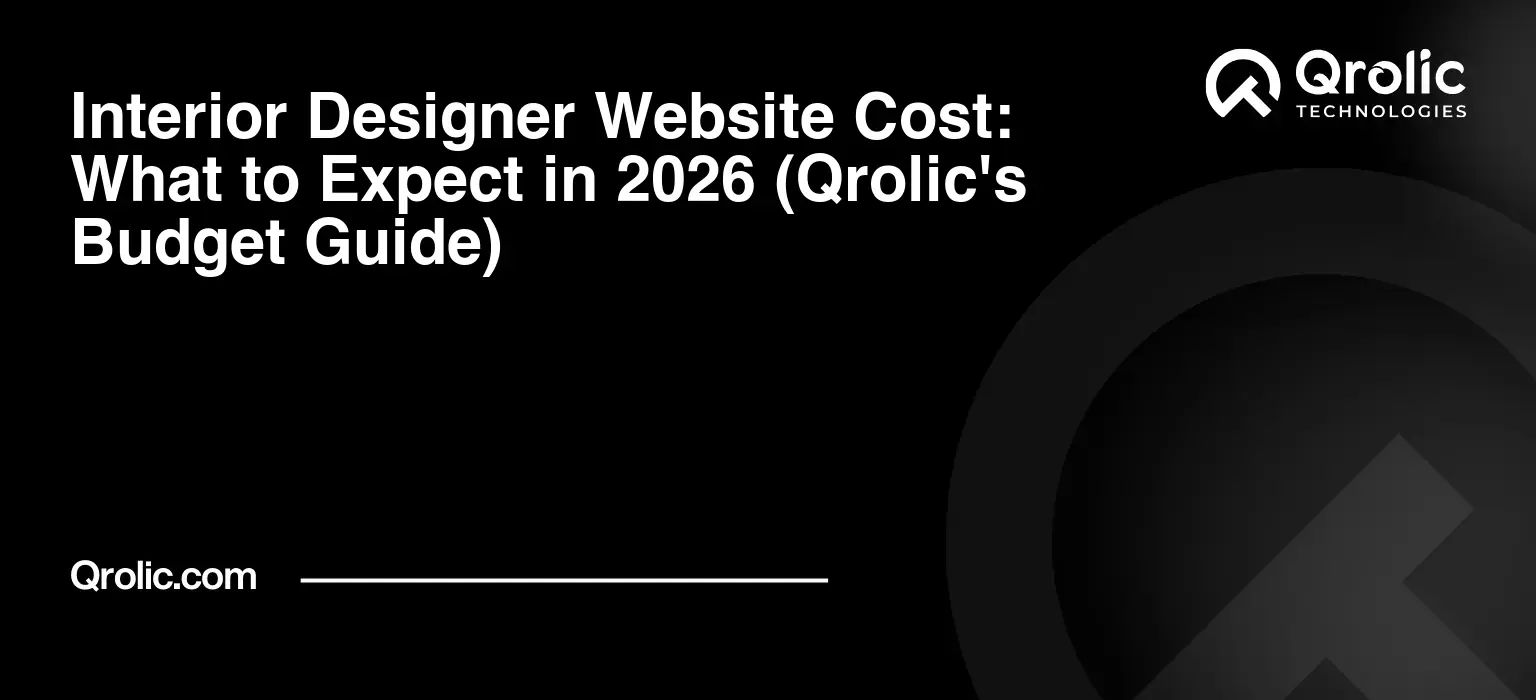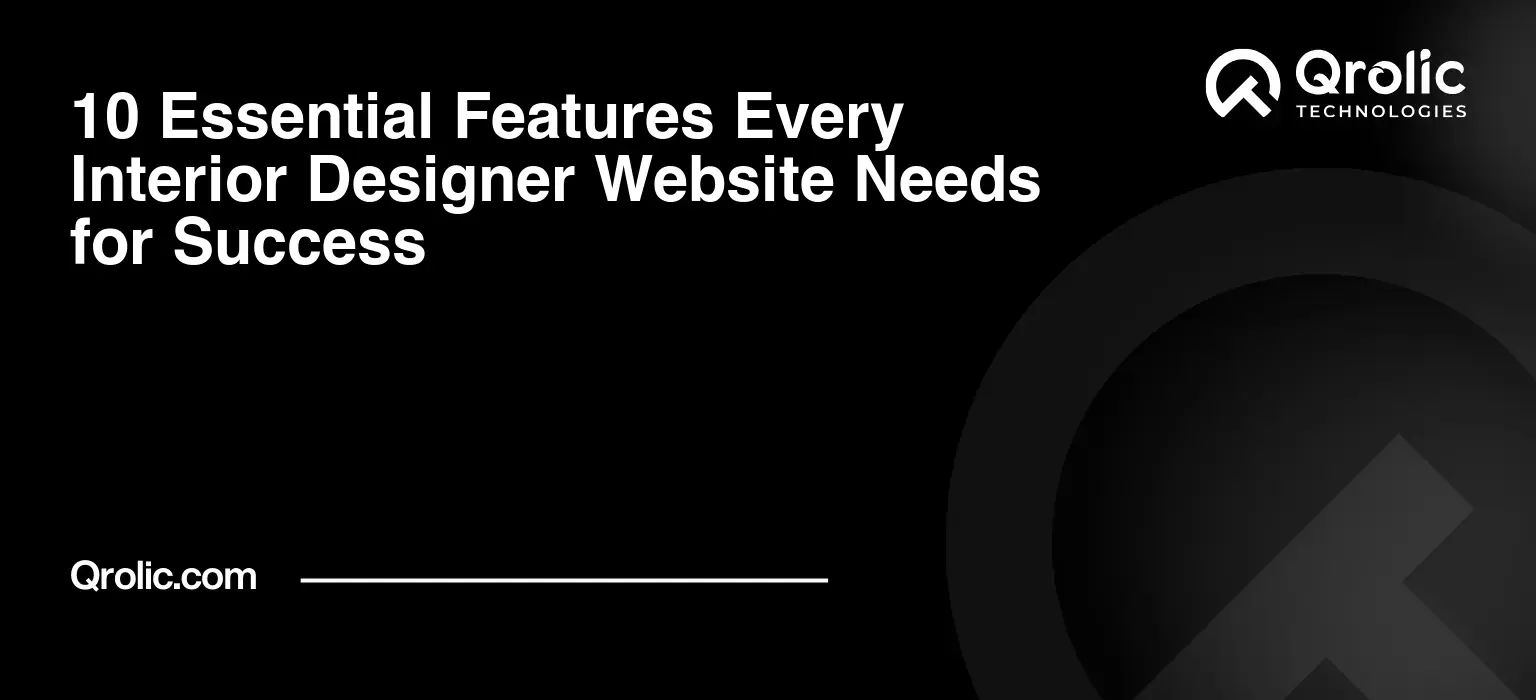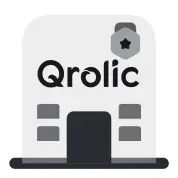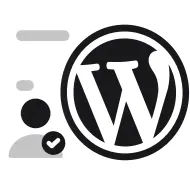Quick Summary:
- A stunning website is vital for interior designers.
- Choose developers skilled in design, UX, and SEO.
- Focus on a great portfolio, mobile, and content.
- Regularly maintain your website for long-term success.
Table of Contents
- Why Interior Designers Need a Stunning Website
- What to Look For in a Website Developer
- Key Features of a High-Performing Website for Interior Designers
- The Importance of Mobile-First Design
- Understanding SEO for Interior Design Websites
- How to Choose the Right Website Developer for You
- Qrolic Technologies: Your Partner in Digital Excellence
- Launching and Maintaining Your Interior Design Website
Why Interior Designers Need a Stunning Website
In today’s visually-driven world, a compelling online presence is not just a luxury, it’s a necessity for interior designers. Your website is often the first point of contact with potential clients. It’s your digital showroom, your portfolio, and your personal brand ambassador. Think about it: prospective clients are unlikely to pick up a phone or send an email unless they’ve been captivated by your online presentation.
The Power of First Impressions: For interior designers, the visual impact is paramount. A poorly designed website sends the wrong message – it can make you look unprofessional, outdated, and even uninspired. On the other hand, a well-crafted website not only showcases your expertise but also embodies your design philosophy. It tells a story, reflects your unique style, and builds trust with potential clients.
Beyond Just a Portfolio: While a strong portfolio showcasing your best projects is crucial, a website for interior designers should be much more than just a gallery. It should serve as a powerful business tool, helping you to:
- Generate Leads: By strategically incorporating call-to-actions and contact forms, your website becomes a lead-generation machine.
- Establish Credibility: Display testimonials, awards, and certifications to build trust and social proof.
- Streamline Communication: Provide easy access to your contact information, services offered, and FAQs, reducing back-and-forth communication.
- Control Your Narrative: Present your brand exactly as you envision it, avoiding misinterpretations or assumptions about your work.
- Expand Your Reach: Attract clients beyond your immediate geographic location with a strong online presence.
The Bottom Line: A professionally built website is an investment in your business that can significantly impact your bottom line. It’s the foundation of your online marketing efforts and a crucial component for long-term success in the competitive world of interior design.
What to Look For in a Website Developer
Choosing the right website developer is a critical decision that can either propel your business forward or hold it back. Not all developers are created equal, and it’s essential to find someone who understands the nuances of the interior design industry and your specific needs.
Beyond the Technicalities: While technical expertise is a given, look for a developer who also possesses:
- A Keen Eye for Design: Your website needs to be visually appealing and reflect your design style. The developer should be able to translate your vision into a functional and beautiful website.
- Understanding of User Experience (UX): A website that is easy to navigate, user-friendly, and intuitive is essential for engaging potential clients.
- SEO Knowledge: Your website needs to be optimized for search engines to rank high in search results. The developer should have a good understanding of SEO best practices.
- Effective Communication Skills: A good website developer will be able to clearly explain the process, listen to your needs, and keep you updated on progress.
- A Proactive Approach: A great developer will not just build your website, they will also provide ongoing support, maintenance, and updates.
- Industry-Specific Expertise: Experience working with interior designers or other visually-oriented businesses is a significant advantage. They will understand the importance of high-quality images, a clean layout, and a focus on visual storytelling.
Key Questions to Ask Potential Developers:
- Can you show me examples of websites you have developed for interior designers or similar businesses? This will give you a sense of their design capabilities and understanding of the industry.
- What is your process for designing and developing a website? This will help you understand their workflow and what to expect.
- Do you provide SEO services and what strategies do you use? SEO is crucial for attracting organic traffic.
- What kind of support and maintenance do you offer? Ongoing support is essential for keeping your website secure and functioning optimally.
- What is your timeline for developing my website? Set clear expectations from the beginning.
- What is your pricing structure and payment terms? Ensure you have a clear understanding of the cost involved.
Red Flags to Avoid:
- Lack of a Portfolio: If a developer can’t show you examples of their work, proceed with caution.
- Poor Communication: If they are difficult to reach or don’t respond to your questions promptly, it’s a sign of poor communication skills.
- Unrealistic Promises: Be wary of developers who promise overnight results or guarantees of top search engine rankings.
- A Focus on Technology Over Design: While technical skills are important, a website for interior designers should prioritize visual appeal and user experience.
- Inflexibility: A good developer will be able to adapt to your specific needs and vision.
- Vague Quotes: Ensure pricing is clear and transparent with no hidden fees.
Key Features of a High-Performing Website for Interior Designers
A website for interior designers needs to be more than just visually appealing; it needs to be functional, user-friendly, and optimized for conversions. Here are some key features to consider:
1. Stunning Visual Portfolio:
- High-Quality Images and Videos: Invest in professional photography and videography to showcase your projects in the best possible light.
- Organized Project Categories: Allow users to easily navigate through different project types (e.g., residential, commercial, specific styles).
- Detailed Project Descriptions: Share details about the project scope, challenges, and design solutions.
- Before & After Slideshows: Showcase the transformative power of your designs.
- Image Zoom Functionality: Allow users to appreciate the details of your work.
2. Intuitive Navigation and User Experience:
- Clear and Concise Menu: Make it easy for users to find what they are looking for.
- Mobile-Friendly Design: Ensure your website is responsive and looks great on all devices (desktops, tablets, and smartphones).
- Fast Loading Speed: Optimize your website for speed to prevent users from abandoning the site.
- Easy-to-Use Contact Form: Make it simple for potential clients to reach out to you.
- Clear Call-to-Actions: Guide users towards taking desired actions, like scheduling a consultation.
3. SEO Optimization for Increased Visibility:
- Keyword Research: Identify the keywords your potential clients are using to search for interior designers.
- On-Page Optimization: Optimize your website content with relevant keywords.
- Technical SEO: Ensure your website is crawlable by search engines.
- Local SEO: Optimize for local searches to attract clients in your area.
- Blog: Regularly publish high-quality blog content to attract and engage your audience.
4. Content Marketing That Attracts Clients:
- Blog Posts: Share your insights, tips, and ideas on interior design trends.
- Case Studies: Showcase your expertise by sharing detailed stories behind your successful projects.
- Client Testimonials: Build trust by displaying positive feedback from satisfied clients.
- About Us Page: Share your personal story and passion for interior design.
- FAQ Section: Answer common questions to streamline communication.
5. Clear Communication & Accessibility:
- Professional Tone: Your website should reflect your brand and communicate professionalism.
- Easy-to-Find Contact Information: Make it simple for potential clients to reach you.
- Clear Pricing Structure: Be transparent about your fees and pricing model.
- Privacy Policy: Ensure you have a privacy policy that is easily accessible.
- Accessibility: Ensure your website is accessible to people with disabilities.
6. Integration with Social Media:
- Social Media Links: Make it easy for visitors to connect with you on social media platforms.
- Social Media Sharing Buttons: Enable users to easily share your content with their network.
- Social Media Feed: Integrate your social media feed to showcase your latest posts.
The Importance of Mobile-First Design
In today’s digital landscape, where smartphones have become extensions of our hands, a mobile-first approach to website design is not optional – it’s crucial. More people are browsing the web on their mobile devices than ever before, and if your website isn’t optimized for this experience, you’re losing potential clients.
Why Mobile-First Matters:
- User Experience: A mobile-first website provides a seamless and intuitive experience for users on their smartphones and tablets.
- Google’s Preference: Google prioritizes mobile-friendly websites in their search results. A mobile-unfriendly website will likely rank lower, impacting your visibility.
- Increased Conversions: A user-friendly mobile experience leads to higher conversion rates, as visitors are more likely to engage with your content and reach out to you.
- Competitive Advantage: A mobile-friendly website sets you apart from competitors with outdated or poorly optimized websites.
- Accessibility: Mobile-first design often encourages cleaner, simpler layouts, which improve accessibility for all users, including those with disabilities.
- Improved Loading Speed: Mobile-first design principles typically emphasize lightweight code and optimized images, leading to faster loading speeds and better user satisfaction.
Key Elements of Mobile-First Design:
- Responsive Layout: Your website should automatically adapt to different screen sizes and resolutions.
- Touch-Friendly Navigation: Navigation should be easy to use with touch gestures.
- Optimized Images: Images should be compressed for faster loading on mobile devices.
- Simplified Content: Content should be concise and easy to scan on smaller screens.
- Large, Clear Fonts: Text should be readable on mobile devices.
- Prioritized Content: Important information should be easily visible above the fold on mobile devices.
Testing Your Mobile Experience:
It is important to regularly test your website on various mobile devices and browsers to ensure a seamless experience. Tools like Google’s Mobile-Friendly Test can help identify and resolve any issues.
Understanding SEO for Interior Design Websites
Search Engine Optimization (SEO) is the process of optimizing your website to rank higher in search engine results pages (SERPs). For interior designers, SEO is crucial for attracting organic traffic and reaching potential clients who are actively searching for their services. Without a solid SEO strategy, your website may remain undiscovered by your target audience.
Key Components of Interior Design SEO:
1. Keyword Research:
- Identify relevant keywords: Think about what your potential clients would search for when looking for an interior designer. This could include terms like “interior designers near me”, “modern interior design”, “residential interior design”, etc.
- Use keyword research tools: Tools like Google Keyword Planner, Ahrefs, and SEMrush can help you identify the most relevant and high-volume keywords.
- Long-tail keywords: Don’t just target short, generic keywords. Focus on long-tail keywords that are more specific and often have less competition (e.g., “luxury interior designer in London”).
2. On-Page Optimization:
- Title Tags & Meta Descriptions: Optimize your page titles and meta descriptions with relevant keywords.
- Heading Tags (H1, H2, H3): Use heading tags to structure your content and incorporate keywords.
- Content Optimization: Write high-quality, informative content that includes your target keywords naturally.
- Image Optimization: Use descriptive alt tags for your images and compress them to reduce load times.
- Internal Linking: Link to relevant pages within your website to improve navigation and SEO.
- URL Optimization: Use SEO-friendly URLs that are short, concise, and descriptive.
3. Technical SEO:
- Mobile-Friendliness: Ensure your website is responsive and mobile-friendly.
- Website Speed: Optimize your website for fast loading speeds.
- XML Sitemap: Submit an XML sitemap to search engines.
- Robots.txt File: Configure your robots.txt file to instruct search engines on which pages to crawl.
- SSL Certificate: Use HTTPS to ensure your website is secure.
4. Local SEO:
- Google My Business: Claim and optimize your Google My Business profile.
- NAP Citations: Ensure your name, address, and phone number (NAP) are consistent across the web.
- Local Directories: List your business in relevant local directories.
- Location Pages: Create location pages for each area you serve.
5. Off-Page SEO:
- Link Building: Build high-quality backlinks from reputable websites.
- Social Media Marketing: Promote your content on social media platforms.
- Online Reputation Management: Monitor and manage your online reviews.
Content is King:
Creating high-quality, informative, and engaging content is essential for SEO. Regularly publish blog posts, case studies, and other valuable content that will attract your target audience and keep them coming back for more.
SEO is an Ongoing Process:
SEO is not a one-time task; it’s an ongoing process that requires continuous monitoring, optimization, and adaptation. Stay up-to-date on the latest SEO trends and best practices to maintain your search engine rankings.
How to Choose the Right Website Developer for You
Choosing the right website developer can feel overwhelming, but breaking down the process into manageable steps can make it less daunting. Here’s how to approach your search:
1. Define Your Needs and Goals:
- What is your budget? Determine your budget beforehand to help narrow down your options.
- What type of website do you need? Are you looking for a simple portfolio website or a more complex e-commerce platform?
- What are your design preferences? What kind of style, colors, and fonts do you like?
- What functionality do you need? Do you need a blog, a contact form, or other specific features?
- What are your long-term goals? Consider your future growth and scalability requirements.
2. Research Potential Developers:
- Online Portfolios: Review the portfolios of various developers to assess their design skills.
- Client Testimonials: Read reviews and testimonials from past clients.
- Industry Experience: Look for developers with experience working with interior designers or related businesses.
- Technical Expertise: Verify that the developer has the necessary technical skills and knowledge.
- Communication Style: Gauge their communication style and responsiveness.
3. Interview Potential Developers:
- Ask Questions: Prepare a list of questions to ask potential developers (refer to the “Key Questions to Ask” section above).
- Discuss Your Vision: Share your vision and design preferences and see how they react.
- Assess Their Understanding of Your Needs: Make sure they understand your business goals and target audience.
- Get Quotes: Get detailed quotes from multiple developers.
4. Evaluate and Compare:
- Compare Proposals: Review the proposals from different developers and compare their offerings.
- Assess Value, Not Just Price: Don’t just go for the cheapest option; prioritize value and quality.
- Check for Compatibility: Choose a developer whose communication style and working approach aligns with yours.
- Review their Terms & Conditions: Make sure you understand their terms and conditions before making any commitments.
5. Make Your Decision:
- Trust Your Gut: Choose a developer you feel comfortable with and whose work you admire.
- Get it in Writing: Get a contract that outlines the scope of work, timeline, and payment terms.
Building a Long-Term Relationship:
Choosing a website developer shouldn’t be a one-time transaction. It’s important to build a long-term relationship with a developer who understands your business needs and can provide ongoing support and maintenance.
Qrolic Technologies: Your Partner in Digital Excellence
At Qrolic Technologies, we understand the unique needs of interior designers. We don’t just build websites; we create digital experiences that elevate your brand and attract your ideal clients. We are a leading website development company specializing in creating visually stunning, highly functional, and SEO-optimized websites for the design industry.
Why Choose Qrolic Technologies?
- Industry Expertise: We have extensive experience working with interior designers and other creative professionals. We understand the importance of visual storytelling, user experience, and brand identity.
- Custom Design Solutions: We don’t believe in one-size-fits-all solutions. We work closely with you to create a unique website that reflects your individual style and brand.
- Stunning Visuals: We prioritize high-quality images and videos to showcase your work in the best possible light.
- Mobile-First Approach: We design and develop websites with a mobile-first approach to ensure a seamless user experience on all devices.
- SEO Optimization: We implement proven SEO strategies to help your website rank high in search engine results.
- Ongoing Support: We provide ongoing support, maintenance, and updates to keep your website secure and functioning optimally.
- Dedicated Team: Our team of experienced designers, developers, and marketers is dedicated to helping you succeed.
Our Services for Interior Designers:
- Custom Website Design: We create bespoke websites that reflect your brand and attract your target audience.
- Portfolio Development: We showcase your best projects with high-quality images, videos, and detailed descriptions.
- Blog Development: We create and maintain a blog to attract and engage your audience with valuable content.
- SEO Services: We implement proven SEO strategies to increase your online visibility and attract organic traffic.
- Social Media Integration: We integrate your website with social media platforms to enhance your brand presence.
- E-commerce Solutions: We can build an online store to sell your products or services.
Our Commitment to You:
At Qrolic Technologies, we are committed to providing you with the highest quality service and delivering results that exceed your expectations. We believe that your website is an investment in your business, and we are dedicated to helping you achieve your goals.
Ready to take your online presence to the next level?
Visit our website today at https://qrolic.com/ to learn more about our services and how we can help you grow your interior design business. Let Qrolic Technologies be your partner in achieving digital excellence.
Launching and Maintaining Your Interior Design Website
Creating and launching your website is just the beginning. To maximize its effectiveness, you need to maintain it, monitor its performance, and make necessary adjustments. Here’s a guide on what to do after launch:
1. Testing and Quality Assurance:
- Thorough Testing: Before officially launching, conduct rigorous testing to identify and fix any bugs or errors. Check all functionality, forms, and links.
- Cross-Browser Compatibility: Test your website on various browsers (Chrome, Firefox, Safari, Edge) to ensure consistent performance.
- Mobile Testing: Test your website on different mobile devices (smartphones and tablets) to ensure responsiveness and usability.
- User Testing: Get feedback from a few people on their experience using your website.
2. Website Monitoring and Analytics:
- Google Analytics: Set up Google Analytics to track website traffic, user behavior, and conversion rates.
- Regular Monitoring: Regularly monitor key metrics like bounce rate, page views, time on site, and conversion rates.
- Analyze Data: Analyze the data to understand what is working well and what needs improvement.
- Identify Trends: Identify trends in user behavior and adjust your strategy accordingly.
- Track Keyword Performance: Monitor how your keywords are ranking in search engine results.
3. Website Updates and Maintenance:
- Regular Updates: Keep your website’s content, plugins, and themes up to date to ensure security and functionality.
- Security Updates: Regularly update your website’s security settings to protect against vulnerabilities.
- Content Updates: Regularly update your website content to keep it fresh and engaging.
- Performance Optimization: Optimize your website for speed and performance.
- Backup Your Website: Regularly back up your website to prevent data loss.
4. SEO Maintenance:
- Monitor Keyword Rankings: Continuously monitor your keyword rankings and make adjustments as needed.
- Build High-Quality Backlinks: Continue to build high-quality backlinks from reputable websites.
- Optimize Your Content: Regularly optimize your content for search engines.
- Monitor Algorithm Changes: Keep up-to-date on the latest search engine algorithm changes and make necessary adjustments to your strategy.
5. Content Marketing Strategy:
- Regularly Publish Blog Posts: Publish high-quality blog posts on topics relevant to your target audience.
- Create Case Studies: Showcase your expertise with in-depth case studies.
- Update Your Portfolio: Regularly update your portfolio with your latest projects.
- Engage with Your Audience: Engage with your audience on social media and respond to their questions and comments.
6. Seek Professional Help When Needed:
- Don’t Hesitate to Ask for Help: If you are struggling with website maintenance or SEO, don’t hesitate to seek help from a professional.
- Regular Website Reviews: Schedule regular website reviews with your developer to identify areas for improvement.
Long-Term Success:
Launching and maintaining a website is an ongoing process. By regularly monitoring your performance, making necessary updates, and continuing to create high-quality content, you can ensure your website continues to attract new clients and support your business goals.
Final Thoughts
A professionally built website is no longer optional for interior designers; it is a critical tool for showcasing your talent, building your brand, and attracting new clients. By understanding the key features of a successful website, choosing the right website developer, and continuously optimizing your online presence, you can achieve your business goals and thrive in the competitive world of interior design. Remember, your website is your digital showroom, and it needs to be as captivating as the spaces you create.









